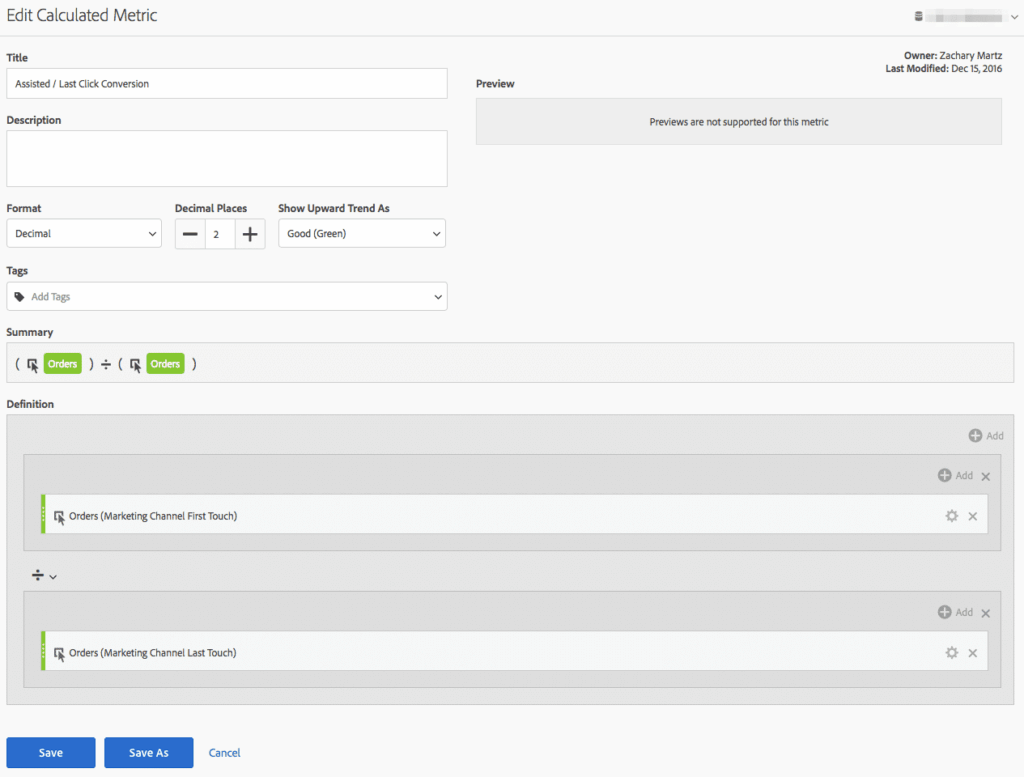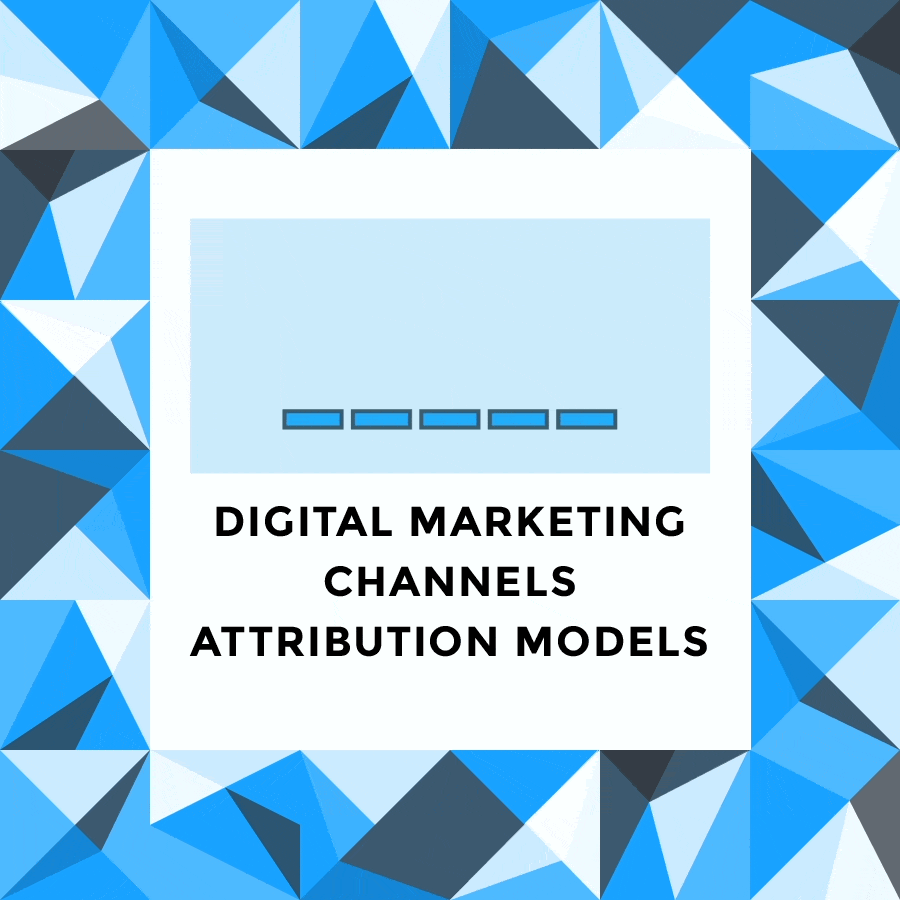Standard Interaction Attribution Models
What is an attribution model? I’m going to cheat here and use the description from Google Analytics Help:
An attribution model is the rule, or set of rules, that determines how credit for sales and conversions is assigned to touchpoints in conversion paths. For example, the Last Interaction model in Analytics assigns 100% credit to the final touchpoints (i.e., clicks) that immediately precede sales or conversions.
The traditional approach to attribution modeling has six basic approaches. However, as the digital marketing landscape evolves, these standards may not tell the best story or may not keep up with the more real-time demands of the current digital marketing world. Here are the standard marketing attribution models used today:
First-Touch
- Definition: A conversion is contributed to the first source a user arrives from within a session timeframe.
- Example: A customer arrives on a website through an email, then through a social media post where they make a purchase. Email would be the marketing channel that receives the credit for the sale and would be the First-Touch point from which the customer arrived.
- Best For: Sites where driving traffic to the site is the goal
Last-Touch
- Definition: A conversion is contributed to the last channel a user has traveled through after previously arriving through another source within a session timeframe.
- Example: A customer arrives on a website through an email, leaves the website and searches for the same website in a search engine, and comes through a sponsored link (SEM). After, they arrive through the search result, complete a conversion, and SEM receives credit for the sale as the Last-Touch source.
- Best For: Sites that are interested in learning what drove the final conversion.
Linear
- Definition: Each step in the user journey is given equal reward for its contribution to the final conversion.
- Example: If a customer arrives at the site through four channels, each channel would get 25% of the contribution on conversion.
- Best For: Sites with diverse product lines that cater to multiple markets/groups.
Weighted
- Definition: A portion of the conversion is distributed to each of the channels in a user conversion journey dependent on the value assigned to each channel.
- Example: A marketing department weighs each channel based on the percentage of revenue made and the cost to maintain the channel. If email is considered to have the highest overhead and the best return, it would get more of the contribution than a CPC campaign with low cost and low return. Both channels would still get some contribution.
- Best For: Sites where budgets or goals are tied higher to some channels.
Time Decay
- Definition: When a conversion is completed closer, chronologically, to the conversion channel, that channel will receive credit.
- Example: A customer arrives through three different channels. The last channel would get the majority of the contribution at 50%, the second channel would get 30%, and the first channel would get 20% of the contribution.
- Best For: Sites where customers do long-term research before purchasing.
Position Based
- Definition: First-Touch and Last-Touch get the bulk of the conversion weight attributed to it, and all of the channels in between get an equal share of the remainder.
- Example: The model values customers who were attracted by a channel and converted by a channel. All other steps would get equal weight. If four channels lead to interactions in the customer journey, the first and last channel each would receive 40% of the contribution, and the other two channels each would receive 10% of the contribution.
- Best For: Sites where customers review recommendations on many sites and review similar products. Leads and final conversions are important, but the research driven sites are also credited.
Conceptual or Case-Based Attribution Models
As explained above, the standard digital marketing attribution models may not be the best fit for all businesses and all situations. These additional models could help offer quicker insights or adapting with channel performance in real-time down to a more one-to-one bases. This type of modeling places business decisions at the forefront and allows the technology to present data that is actionable in the moment. Here are some of the conceptual or case-based attribution models you may want to use:
Gluttonous
- Definition: A conversion is designated to a channel 100% of the time regardless of where it falls in the interaction funnel.
- Example: A customer comes in through a high-performing source. Regardless of when or where in the funnel they come, that touch automatically consumes all of the interaction coverage, and revenue is placed into a specified channel.
- Best For: Best for sites that are using test performance to look at one specific channel growth.
Exclusive
- Definition: A conversion is attributed to all channels in a journey except for a specific channel that is excluded. The excluded channel is only captured if it is the First-Touch or the Last-Touch channel.
- Example: A customer comes to a site from email, then comes to the site from Facebook, then comes to the site from Instagram, and converts when coming to the site through a sponsored search ad (SEM). We have a rule setup to exclude Instagram when a customer also comes through Facebook. All channels would receive a contribution amount except Instagram. This rule could be intended to prevent double paying Instagram for the same post on different parts of the same social media network.
- Best For: Preventing double counting on networks with cross-over placements.
Full Attribution
- Definition: Every channel in the model receives 100% of the conversion contribution. This method looks at general conversion at any point in a user’s site journey within the session window.
- Example: A customer arrives through three different marketing channels and converts on an order of $29.99. Each channel would receive credit for $29.99.
- Best For: Sites looking to review frequency of channel activity vs. purchase activity in a channel against one another.
Algorithmic / Artificial Intelligence
- Definition: A conversion is attributed to a channel based off deep learning algorithms that detect and adapt with ebb and flow of business. This approach adjusts the percentage of contribution each channel receives as the decision data changes.
- Example: A very specific traffic source and purchase destination is seen as high value, therefore that combination will be weighted higher within the channel structure for contribution. A month later the same combination is now a low or normal performer, so the contribution is adjusted accordingly without manual corrections.
- Best For: Sites that are able to constantly interact with customers in realtime to reward content and network that provides a stronger lead or long-term user.
A quick KPI ~ Assisted Last-Click (ALC) or Direct Conversion
In google this is covered under “Assisted/Last Click or Direct Conversions and First/Last Click or Direct Conversions:” whereas in omniture a custom metric can be created. Create a custom metric that calculates “Orders First-Touch” over “Orders Last-Touch”.

When created and reviewed, the closer the channel Assisted value is to “0,” the more responsible the channel is for converting sales than helping other channels. If the value is closer to “1,” the channel both directly creates sales and helps other channel equally. If a channel’s value is above “1,” the more it is a helping other channels convert.
- 0 = Direct Converter
- 1 = Converts & Assists Equally
- 1+ = Assists Channels
Should a Channel have an Interaction Override?
The short answer is yes, and here is an explanation why:
Interaction overrides allow for an interval of time or an event to disqualify a Channel from receiving contribution in a conversion. This can be extremely helpful to compensate for planned outliers or to insure extraneous business cases do not double count towards contribution pay outs.
For instance, this could be used to insure social influencers that are paid to represent a product in a campaign are not also receiving revenue from a link-sharing network that gets referral credit for a product click-through conversion. It could also be used to disqualify traffic from a third-party retailer that has exclusive products on their website but also refers traffic to the main brand website. The disqualification would prevent conversions on products they have on the third-party website and would give conversion contribution if the traffic comes from their exclusive styles.
What Attribution Model is Best for your Business?
This is a bit of a loaded question. There are many factors that can go into choosing an attribution model. There is also a possibility that there may be more than one model that is needed to answer the questions you have. Please contact me or leave comments below to talk though which of the above models is best for you.


Leave a Reply
You must be logged in to post a comment.